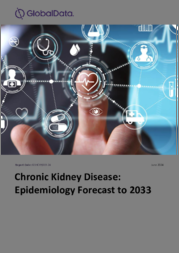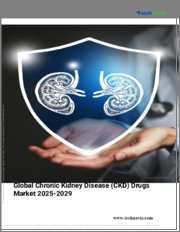
|
시장보고서
상품코드
1511595
만성신장병(CKD) : 역학 예측(-2033년)Chronic Kidney Disease: Epidemiology Forecast to 2033 |
||||||
만성신장병(CKD, ICD-10 코드 N18)은 시간의 경과와 함께 신장 기능이 서서히 저하하는 것을 특징으로 하는 질환입니다. 그 결과, 체내에 여분의 수분 및 노폐물이 축적합니다. 초기 단계에 CKD는 거의 무증상입니다. 질환이 진행하면 증상이 악화되며, 최종적으로는 신부전에 이릅니다(Centers for Disease Control and Prevention, 2024 a). 만성신장병이 진행하면 체내 수분, 전해질, 노폐물이 위험한 레벨까지 축적합니다(Bentall, 2023). 신장 기능의 중요한 지표인 사구체 여과량(GFR)은 혈액중 크레아티닌의 수량에 의해 결정됩니다. Kidney Disease Improving Global Outcomes(KDIGO) 분류 시스템은 GFR 측정과 CKD 진단의 표준으로 간주되고 있습니다(Levin등, 2013).
주요 7 시장에서 CKD의 총환자 수는 2023년 1억 1,029만 9,913명에서 2033년까지 1억 2,107만 2,673명으로 증가하며, 연간 성장률(AGR)은 0.98%에 달할 것으로 예측됩니다. 2033년, 미국이 4,508만 7,454명으로 주요 7 시장에서 가장 많으며, 이탈리아는 377만 8,783명으로 가장 적습니다. CKD로 진단된 환자 수는 2023년 2,108만 7,380명에서 2033년에 2,297만 5,558명으로 증가할 것으로 예측되며, AGR은 0.90%입니다. 2033년, 미국이 583만 4,008명으로 주요 7 시장에서 가장 많으며, 이탈리아는 93만 3,881명으로 CKD 환자 수가 가장 적습니다. GlobalData의 역학자는 CKD의 총환자 수와 진단된 환자 수의 증가를 각 시장의 인구통계와 진단율의 변화에 의한 것으로 보고 있습니다.
만성신장병(CKD)의 주요 7 시장(미국, 프랑스, 독일, 이탈리아, 스페인, 영국, 일본)에 대해 조사분석했으며, 연령, 성별, 병기별 환자 수의 데이터 및 10년간 예측을 제공하고 있습니다.
목차
제1장 만성신장병 : 주요 요약
- 촉매
- 관련 리포트
- 향후 리포트
제2장 역학
- 질환의 배경
- 위험 요인과 합병증
- 세계와 과거 동향
- 주요 7 시장의 예측 방법
- CKD의 역학적 예측(2023-2033년)
- CKD의 총환자 수
- CKD의 총환자 수 : 병기별
- CKD로 진단된 환자 수
- CKD로 진단된 환자 수 : 연령별
- CKD로 진단된 환자 수 : 성별
- CKD로 진단된 환자 수 : 병기별
- CKD로 진단된 환자 수(투석 의존에 기반)
- 논의
- 역학적 예측 인사이트
- COVID-19의 영향
- 분석의 한계
- 분석의 강점
제3장 부록
KSA 24.07.23Chronic kidney disease (CKD), or chronic renal disease (International Classification of Diseases 10th Revision [ICD-10] code = N18), is a condition characterized by a gradual loss of kidney function over time. This leads to the accumulation of excess fluid and waste in the body. In the early stages, CKD is a largely asymptomatic condition. As the disease progresses, symptoms worsen and eventually lead to kidney failure (Centers for Disease Control and Prevention, 2024a). Advanced chronic kidney disease can lead to dangerous levels of fluid, electrolytes, and waste accumulating in the body (Bentall, 2023). The glomerular filtration rate (GFR), a key measure of kidney function, is determined by the amount of creatinine in the blood. The Kidney Disease Improving Global Outcomes (KDIGO) classification system is considered to be the standard for GFR measurement and the diagnosis of CKD (Levin et al., 2013).
In the 7MM, the total prevalent cases of CKD are expected to increase from 110,299,913 cases in 2023 to 121,072,673 cases in 2033, at an annual growth rate (AGR) of 0.98%. In 2033, the US will have the highest number of total prevalent cases of CKD in the 7MM, with 45,087,454 cases, and Italy will have the fewest total prevalent cases of CKD with 3,778,783 cases. The diagnosed prevalent cases of CKD are expected to increase from 21,087,380 cases in 2023 to 22,975,558 cases in 2033, at an AGR of 0.90%. In 2033, the US will have the highest number of diagnosed prevalent cases of CKD in the 7MM, with 5,834,008 cases, and Italy will have the fewest diagnosed prevalent cases of CKD with 933,881 cases. GlobalData epidemiologists attribute the increase in the total and diagnosed prevalent cases of CKD to changes in population dynamics and the diagnosis rate in each market.
Scope
- This report provides an overview of the risk factors, comorbidities, and global and historical trends for CKD in the seven major pharmaceutical markets (7MM: US, France, Germany, Italy, Spain, UK, and Japan). It includes a 10-year epidemiological forecast for the total prevalent cases and diagnosed prevalent cases of CKD. The total and diagnosed prevalent cases of CKD are further segmented by age (18-29 years, 30-39 years, and by 10-year age groups up to 80 years and older), sex, and stage (stage I, stage II, stage IIIa, stage IIIb, stage IV, and stage V) in these markets.
- The diagnosed prevalent cases of CKD are further segmented by dialysis-dependent (including both hemodialysis and peritoneal dialysis) and non-dialysis dependent. The model associated with the report also provides the diagnosed prevalent cases of CKD by comorbidities (hypertension, diabetes, and CVD) in the 7MM markets.
- This epidemiology forecast for CKD is supported by data obtained from peer-reviewed articles and population-based studies. The forecast methodology was kept consistent across the 7MM to allow for a meaningful comparison of the forecast diagnosed prevalent cases of CKD across these markets.
Reasons to Buy
- The Chronic Kidney Disease (CKD) epidemiology series will allow you to:
- Develop business strategies by understanding the trends shaping and driving the global MM market.
- Quantify patient populations in the global CKD market to improve product design, pricing, and launch plans.
- Organize sales and marketing efforts by identifying the age groups that present the best opportunities for CKD therapeutics in each of the markets covered.
Table of Contents
Table of Contents
1 Chronic Kidney Disease: Executive Summary
- 1.1 Catalyst
- 1.2 Related reports
- 1.3 Upcoming reports
2 Epidemiology
- 2.1 Disease background
- 2.2 Risk factors and comorbidities
- 2.3 Global and historical trends
- 2.4 7MM forecast methodology.
- 2.4.1 Sources
- 2.4.2 Forecast assumptions and methods.
- 2.4.3 Total prevalent cases of CKD
- 2.4.4 Total prevalent cases of CKD by stage
- 2.4.5 Diagnosed prevalent cases of CKD.
- 2.4.6 Diagnosed prevalent cases of CKD by stage.
- 2.4.7 Diagnosed prevalent cases of CKD based on dialysis dependence.
- 2.5 Epidemiological forecast for CKD (2023-33)
- 2.5.1 Total prevalent cases of CKD
- 2.5.2 Total prevalent cases of CKD by stage
- 2.5.3 Diagnosed prevalent cases of CKD.
- 2.5.4 Age-specific diagnosed prevalent cases of CKD
- 2.5.5 Sex-specific diagnosed prevalent cases of CKD
- 2.5.6 Diagnosed prevalent cases of CKD by stage.
- 2.5.7 Diagnosed prevalent cases of CKD by dialysis dependence.
- 2.6 Discussion
- 2.6.1 Epidemiological forecast insight
- 2.6.2 COVID-19 impact.
- 2.6.3 Limitations of the analysis
- 2.6.4 Strengths of the analysis
3 Appendix
- 3.1 Bibliography
- 3.2 About the authors
- 3.2.1 Epidemiologist
- 3.2.2 Reviewers
- 3.2.3 Vice President of Disease Intelligence and Epidemiology
- 3.2.4 Global Head of Pharma Research, Analysis, and Competitive Intelligence
- Contact Us

















